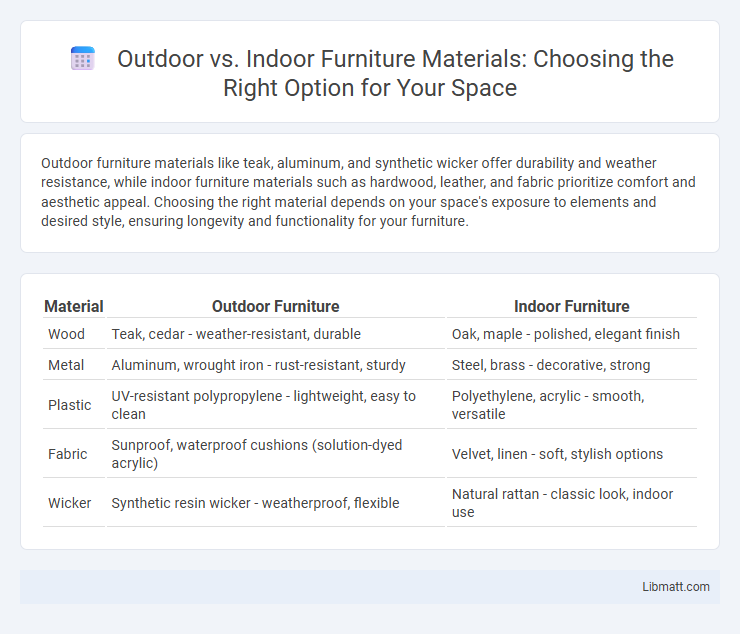Outdoor furniture materials like teak, aluminum, and synthetic wicker offer durability and weather resistance, while indoor furniture materials such as hardwood, leather, and fabric prioritize comfort and aesthetic appeal. Choosing the right material depends on your space's exposure to elements and desired style, ensuring longevity and functionality for your furniture.
Table of Comparison
| Material | Outdoor Furniture | Indoor Furniture |
|---|---|---|
| Wood | Teak, cedar - weather-resistant, durable | Oak, maple - polished, elegant finish |
| Metal | Aluminum, wrought iron - rust-resistant, sturdy | Steel, brass - decorative, strong |
| Plastic | UV-resistant polypropylene - lightweight, easy to clean | Polyethylene, acrylic - smooth, versatile |
| Fabric | Sunproof, waterproof cushions (solution-dyed acrylic) | Velvet, linen - soft, stylish options |
| Wicker | Synthetic resin wicker - weatherproof, flexible | Natural rattan - classic look, indoor use |
Introduction to Outdoor vs Indoor Furniture Materials
Outdoor furniture materials are designed to withstand weather elements such as rain, UV rays, and temperature fluctuations, commonly featuring durable options like teak, aluminum, and synthetic wicker. Indoor furniture materials prioritize comfort and aesthetics, often utilizing softer fabrics, wood veneers, and metal frames without the need for weather resistance. Your choice between outdoor and indoor furniture materials should consider durability, maintenance, and the specific environment where the furniture will be used.
Key Differences Between Outdoor and Indoor Furniture
Outdoor furniture materials prioritize weather resistance and durability, often using synthetic wicker, teak, aluminum, or powder-coated steel to withstand moisture, UV rays, and temperature fluctuations. Indoor furniture materials emphasize comfort and aesthetics with natural wood, upholstered fabrics, leather, and softer finishes that are not designed for exposure to harsh environmental conditions. The key difference lies in outdoor materials being engineered for longevity and low maintenance in variable climates, while indoor materials focus on style, comfort, and texture suited for controlled environments.
Durability: Weather Resistance vs. Climate Control
Outdoor furniture materials like teak, aluminum, and synthetic wicker offer superior durability and weather resistance, withstanding rain, UV rays, and temperature fluctuations without deteriorating. Indoor furniture materials such as hardwood, leather, and fabric excel in climate-controlled environments but may degrade quickly if exposed to moisture or direct sunlight. Choosing your furniture based on the intended setting maximizes longevity and maintains aesthetic appeal.
Popular Materials for Outdoor Furniture
Popular materials for outdoor furniture include teak, aluminum, and synthetic wicker, chosen for their durability and weather resistance. Teak is prized for its natural oils that resist moisture and insects, ensuring longevity in various climates. Aluminum offers rust-free strength and lightweight portability, while synthetic wicker combines aesthetic appeal with UV and water resistance for year-round outdoor use.
Popular Materials for Indoor Furniture
Popular materials for indoor furniture include hardwoods like oak, maple, and walnut, prized for their durability and classic aesthetic. Upholstery options such as leather, velvet, and linen provide comfort and style, while engineered wood and MDF offer affordable and versatile solutions. You can enhance your living space by selecting materials that balance durability, comfort, and design appeal.
Maintenance Requirements: Outdoor vs. Indoor Materials
Outdoor furniture materials like teak, aluminum, and synthetic wicker demand regular maintenance such as sealing, rust prevention, and cleaning to withstand weather elements. Indoor furniture materials, including hardwood, leather, and fabric upholstery, typically require less frequent upkeep, focusing on dusting and spot cleaning to maintain appearance. Understanding your furniture's material maintenance needs ensures longevity and preserves the aesthetic quality of both your outdoor and indoor spaces.
Aesthetics and Style Considerations
Outdoor furniture materials like teak, wrought iron, and resin wicker offer weather-resistant durability while enhancing natural surroundings with rustic or coastal aesthetics. Indoor options such as leather, velvet, and solid wood provide rich textures and refined finishes that complement sophisticated or contemporary interior styles. Your choice in furniture materials significantly influences the overall ambiance, balancing functionality with visual appeal tailored to the setting.
Comfort and Usability Factors
Outdoor furniture materials like weather-resistant wicker, teak, and aluminum offer durability and comfort by withstanding sun, moisture, and temperature fluctuations, ensuring long-lasting usability. Indoor materials such as hardwood, velvet, and leather provide a softer, more cushioned experience tailored for controlled environments but may degrade quickly if exposed outdoors. Your choice should balance comfort with the specific environmental demands to maximize furniture usability and lifespan.
Price Comparison: Outdoor vs. Indoor Materials
Outdoor furniture materials, such as teak, aluminum, and synthetic wicker, generally cost more upfront due to their weather-resistant properties and durability. Indoor furniture materials like solid wood, fabric upholstery, and leather tend to be less expensive initially but may require more maintenance or replacement if exposed to harsh conditions. Understanding these price differences helps you make an informed decision based on your budget and intended furniture use.
Sustainability and Eco-Friendly Material Options
Outdoor furniture often utilizes materials like recycled plastics, teak, and aluminum, which offer durability and weather resistance while promoting sustainability. Indoor furniture typically features sustainably sourced wood, bamboo, or organic fabrics that reduce environmental impact and support eco-friendly living spaces. You can choose furniture made from renewable resources and non-toxic finishes to enhance your home's environmental footprint without sacrificing style.
outdoor vs indoor furniture materials Infographic

 libmatt.com
libmatt.com